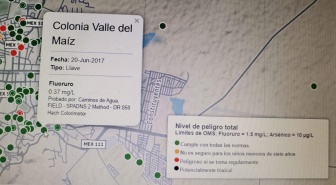Water quality in San Miguel neighborhoods, according to Caminos de Agua’s monitoring map.
News Category: News, Community News, and General Discussion
-
According to a study published on the website of the association Caminos de Agua, where there is also a map with data on water quality in the urban and rural areas of the municipality, this says about the water quality in each of the colonies of the city?.
In this monitoring map-enabled in the portal of the association, it says that the colonias with the most contaminated water of chemicals such as arsenic and fluoride, are Santa Cecilia, Insurgentes, Mexiquito, San Rafael, Linda Vista, Olimpo, Ejido de Tirado, Centro, las Brisas, Linda Vista and Santa Julia, the water from the wells that supply these, contains a high degree of arsenic and/or fluoride, and can be dangerous if taken regularly.
Other neighborhoods such as San Luis Rey, fraccionamiento Insurgentes, Francisco Villa, Obraje, Guadalupe, Providencia, San Antonio, and San Martín, also have well water contaminated with these chemicals, although the quality standards are more moderate and according to the parameters shown on the map, the water is not safe for children under 7 years of age.
The map indicates that the cleanest and safest water is in colonias such as: Independencia, Azteca, Guadiana, Valle del Maíz, Allende, Malanquin, Palmita, Luciérnaga, La Luz, Los Frailes, La Lejona, Insurgentes.

Anyone can view this water quality monitoring map, monitor the water quality in their neighborhood or community, by clicking on “this link” that takes you to the Caminos de Agua website, it is very simple and practical to use, with circles filled in green, orange, red and black, indicating the level of danger according to the level of arsenic detected.
Just click on the circle and you will see a box with data on the level of arsenic or fluoride detected in the well water supplying your neighborhood, and compare it with the lower box to your right and you realize whether or not it exceeds the standards set by the WHO and the Conagua.
-


Leave a Reply